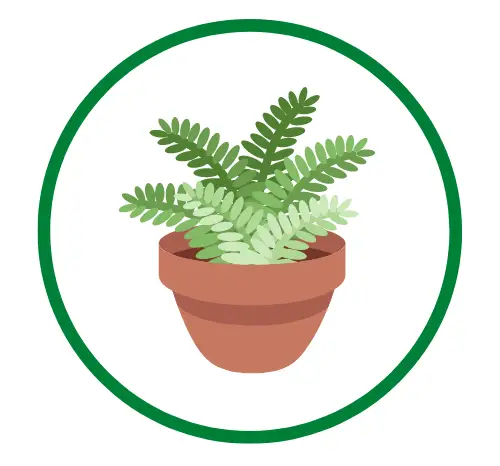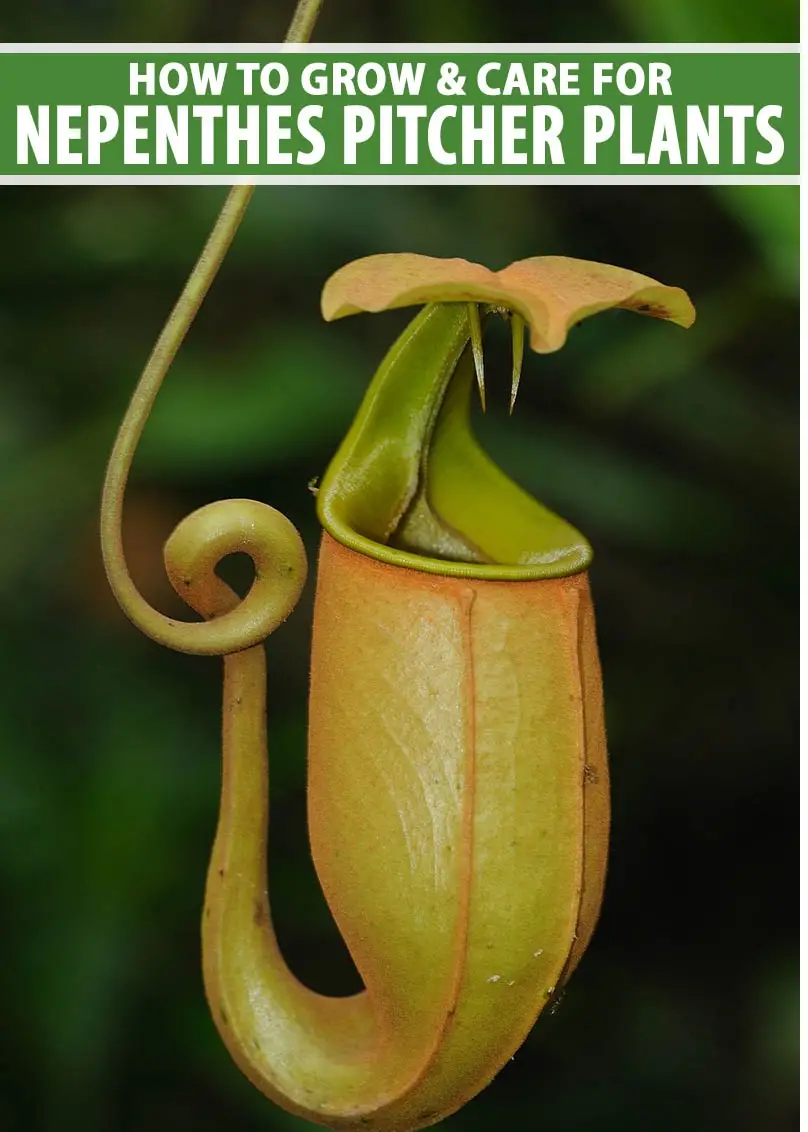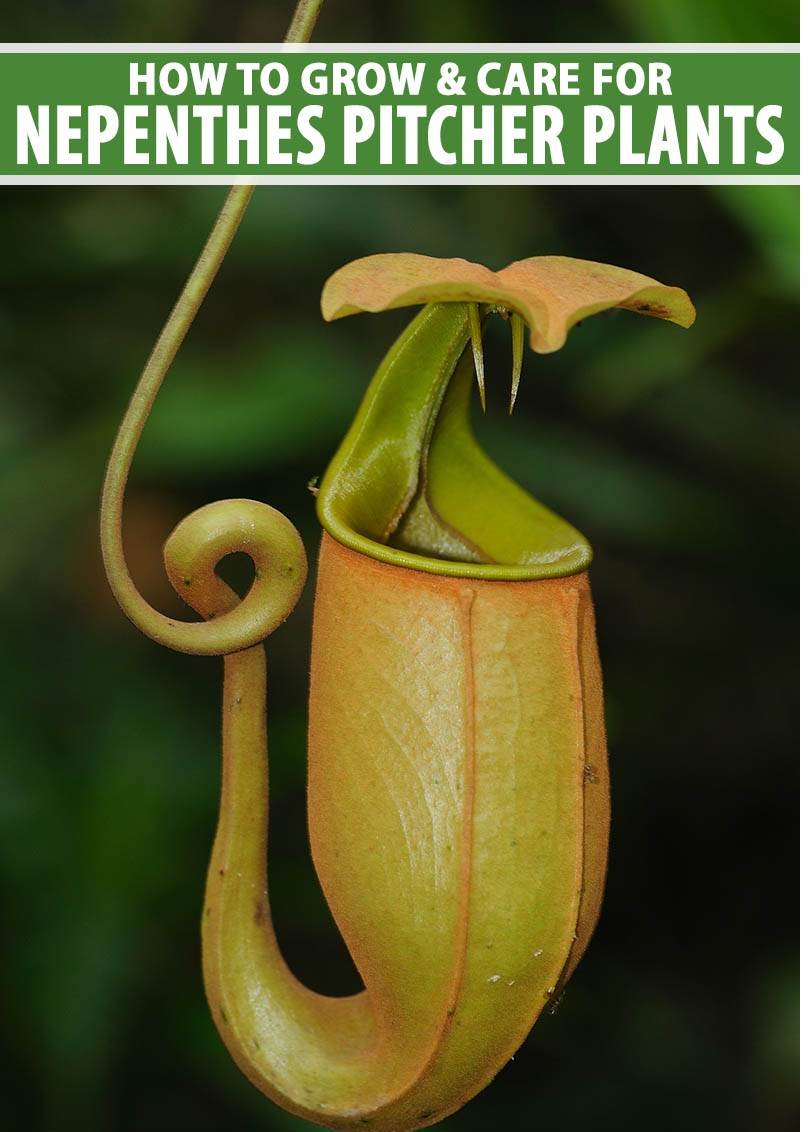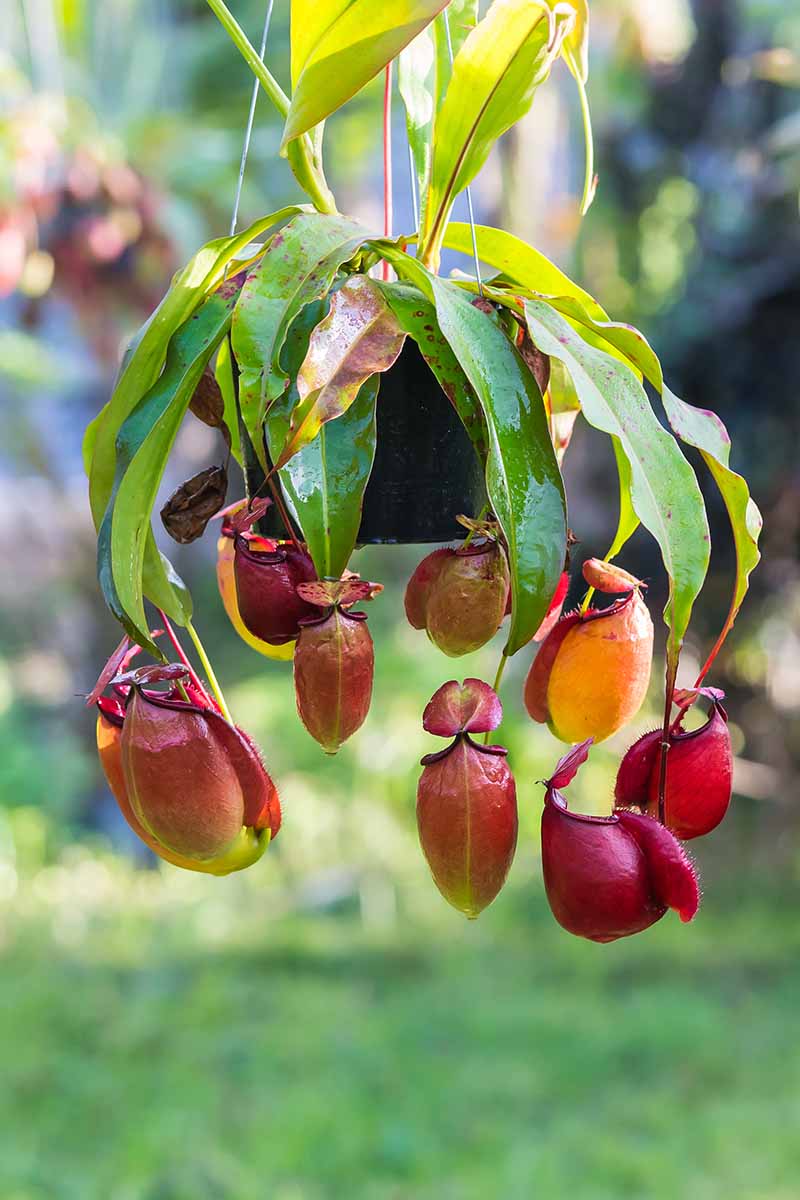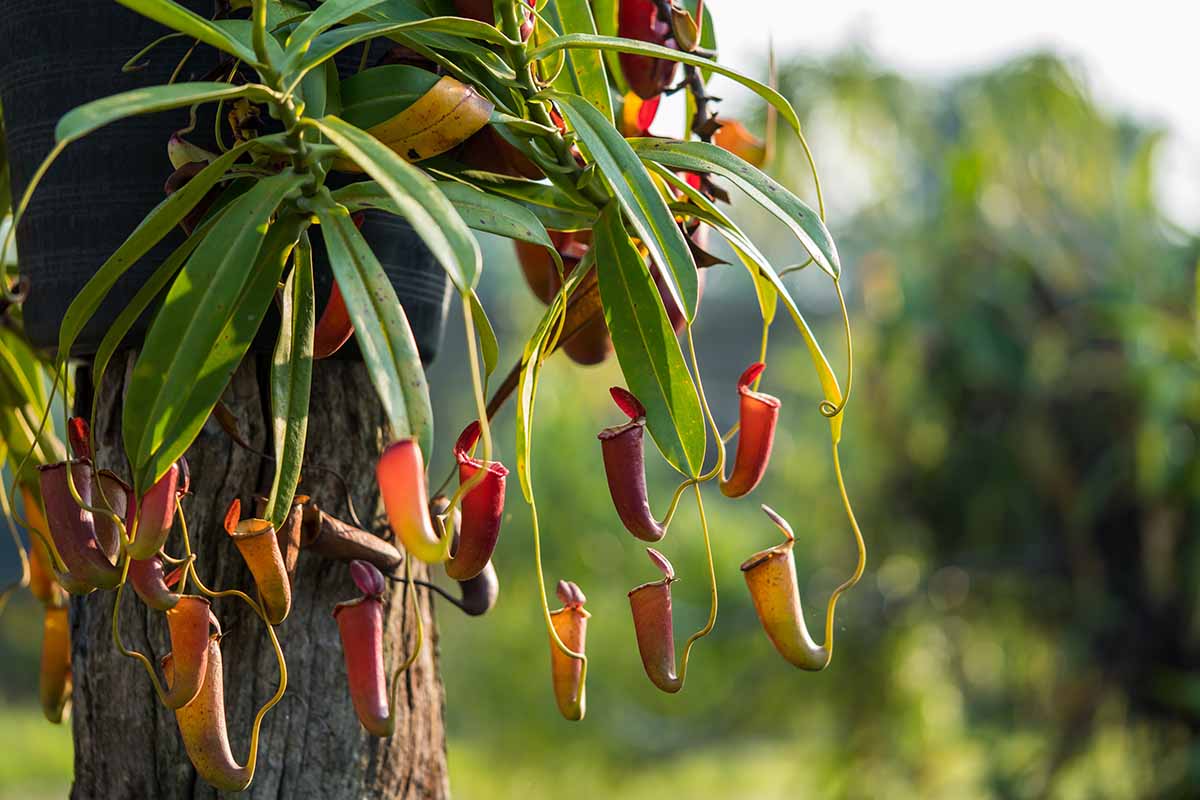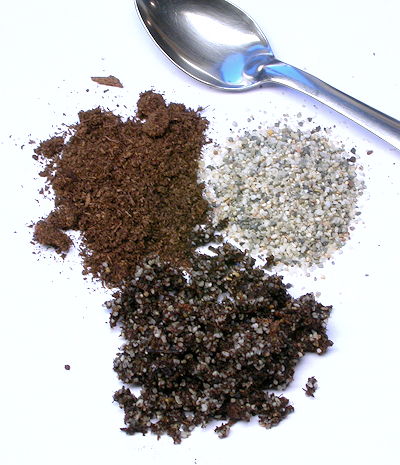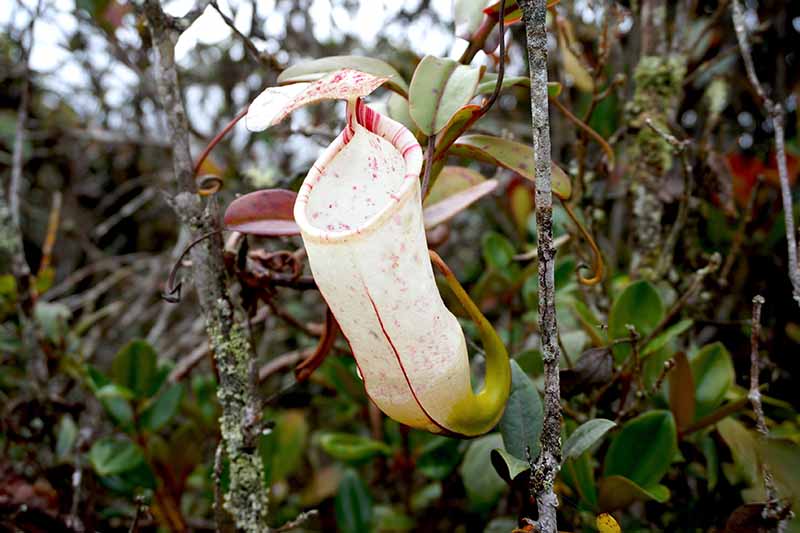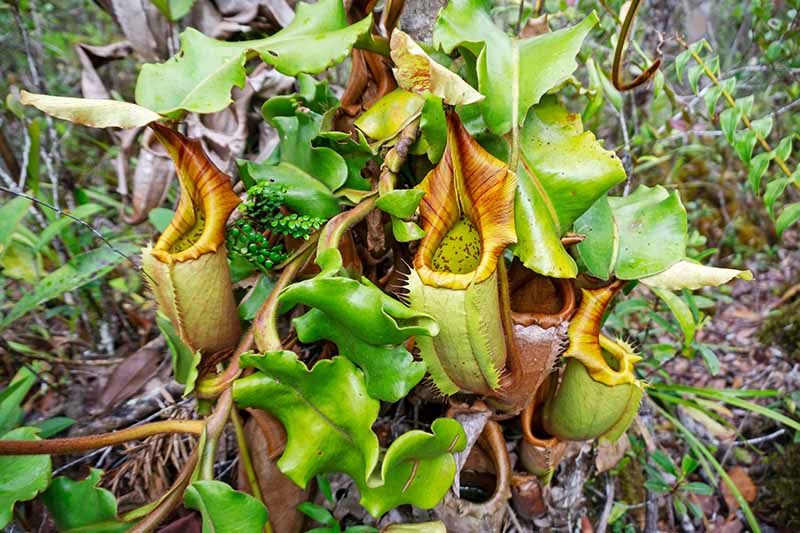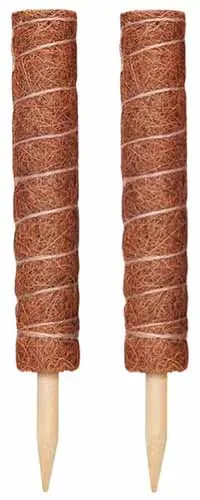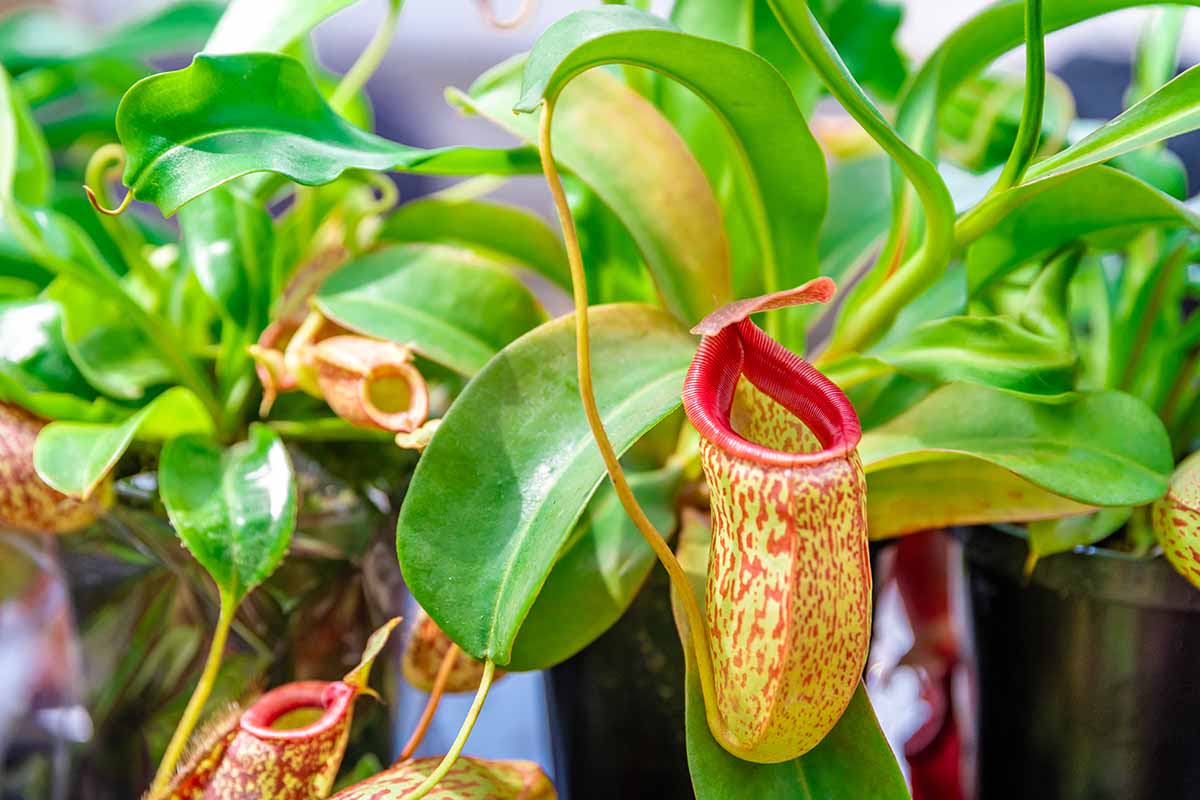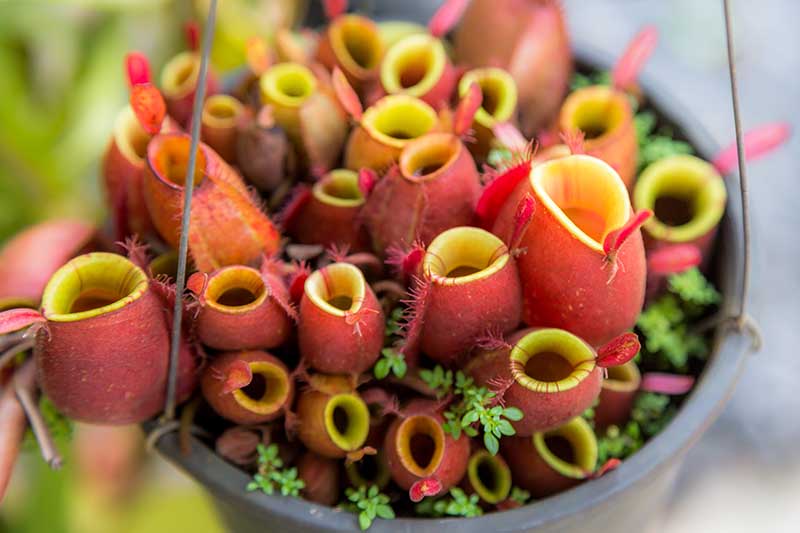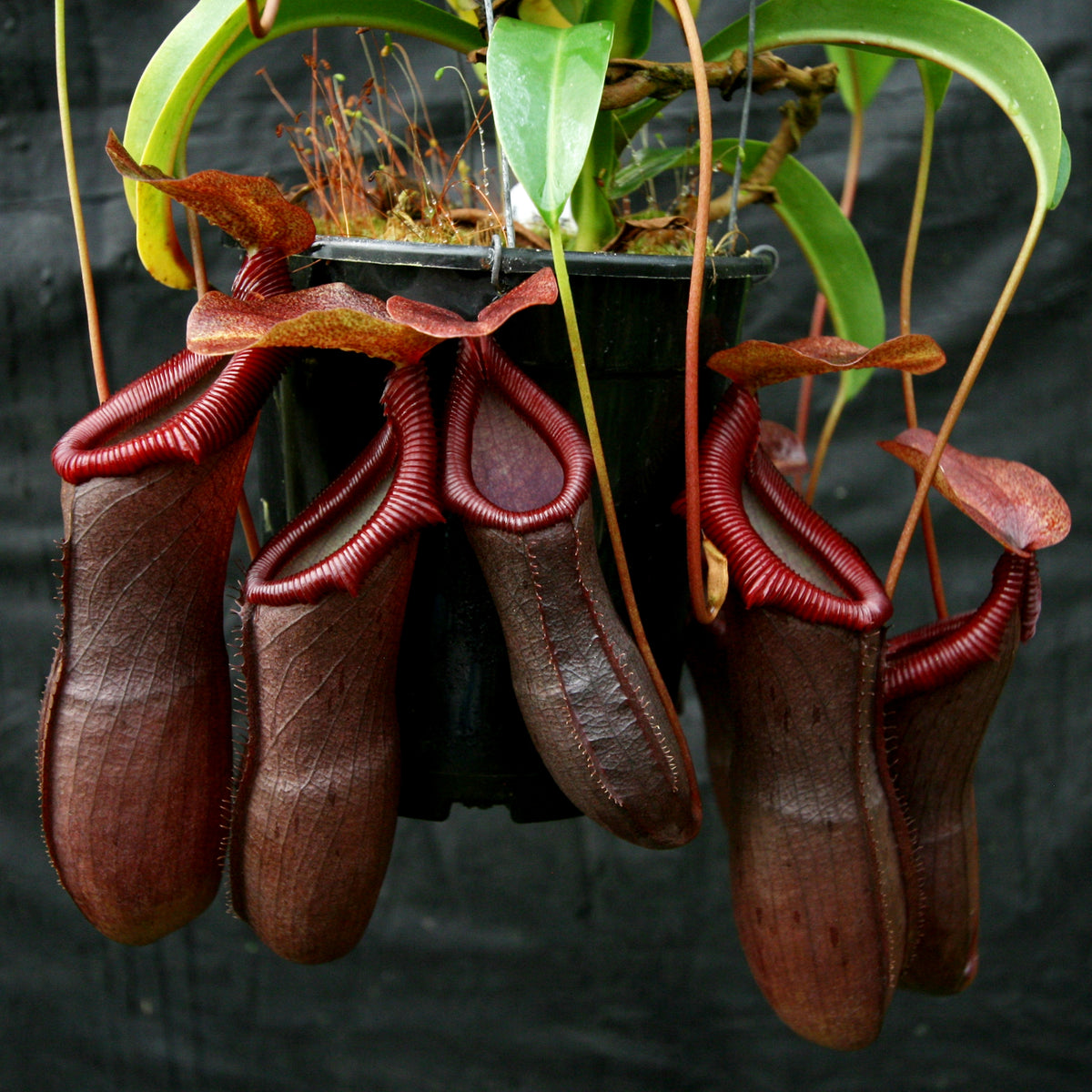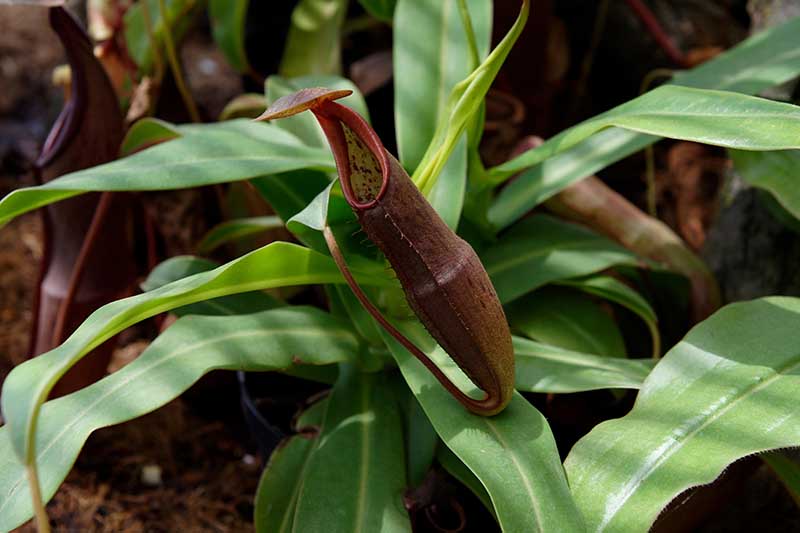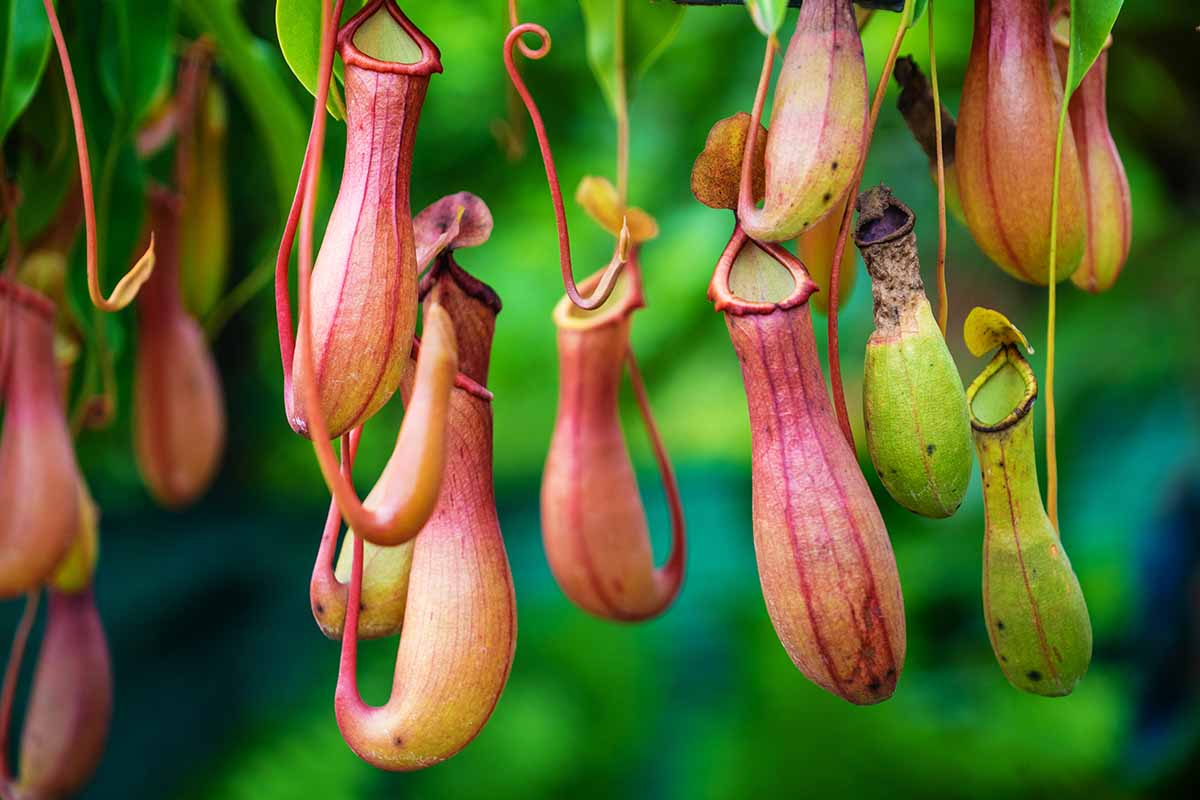Nepenthes Care: A Different Approach to Growing Tropical Pitcher Plants
Welcome to my article on nepenthes care. This is less advice on “how YOU should grow Nepenthes plants” and more of a topical exploration and defense of my methodology.
I’ll go over the main aspects of care, such as temperature, potting medium, water quality, watering techniques, misting, humidity, light, and fertilizer, in the sections I’ll be covering. I’ll compare conventional wisdom with my viewpoint so you can understand why I’ve decided to take a particular tack. To skip to the section you’re interested in, click those links, or keep reading to get the full story.
It can be challenging to grow some carnivorous plants indoors. Because they have very specific requirements, pitcher plants like species of the Sarracenia genus are among those that are difficult to grow as houseplants. And some of them can get quite big, making it difficult to fit them indoors.
The majority of the carnivores are bog dwellers that require moist soil and bright, direct sunlight for 12 or more hours every day to stay healthy, but some species, like those in the genus Nepenthes plants, require very different environmental factors to thrive.
Tropical pitcher plants, also known as “monkey cups” or “monkey jars,” require a little more maintenance than your typical pothos or ficus, but by doing some research beforehand, you’ll be much better equipped to handle that challenge. Prepare to learn!
Nepenthes Tropical Pitcher Plant: What Are They?
Nepenthes, a genus of tropical pitcher plants, is primarily indigenous to Australia, Madagascar, and parts of Southeast Asia.
The majority are tropical perennials that can be found on mountain slopes where they enjoy the humid climate and warm days and cool nights. Some of them can even withstand freezing nighttime temperatures because they are tropical alpine varieties.
Because it was once believed that monkeys drank water from the containers these plants produce, you may hear people refer to them as “monkey cups.” Unfortunately, this has not been the case, but the name has persisted.
Numerous varieties have a vining habit thanks to their shallow roots and climbing stems. Along the stems, long, strap-like leaves are produced.
The fluid in the pitcher traps is used to drown and digest the prey, and the downward-pointing hairs and waxy coating inside make it challenging to escape. Although rodents, lizards, and birds have also reportedly been caught by these carnivorous plants, catch insects make up the majority of their prey.
Although some species do not produce these, many species also have a lid or operculum, that grows above the pitchers to stop the digestive liquid inside from being diluted when it rains.
They produce flowers that are pollinated by insects, and the aromas of those flowers can range from sweet to more fungal-smelling, which may not be as pleasing to humans.
These particular pitcher plant varieties are distinctive in that they actually produce two different kinds of traps, usually with larger ones that rest on the ground close to the base of plants and aerial pitchers that may have different features or appearances. Mature plants in the wild are most likely to exhibit both of these.
Although the plants in this genus are not known to be toxic to animals, cats may experience mild digestive upset if they consume them. It can be difficult to keep your feline friends out of the dangling pitchers, but hanging them near the ceiling and away from furniture or placing them in a terrarium where they are out of reach can work.
Growing Tropical Pitcher plants in a terrarium Terrariums are very good for growing Tropical Pitcher plants. To grow your Nepenthes in a terrarium, choose a large-sized tank that will be similar to a mini hothouse. For example, this terrarium can be used both indoors and outdoors.
One of the most crucial things to understand about Nepenthes species is that there is no one-size-fits-all approach to their care. They are divided into two types: highland nepenthes species and lowland species, and each has different requirements.
The two kinds are further divided into epiphytic and cluster-forming specimens, and once more, each of these groups has its own unique preferences and needs.
Recommended Growing Conditions
Most of the 170 species in the Nepenthes genus are pale tropical, meaning they are native to areas with warm, humid weather all year round.
Since they prefer very similar conditions and typically grow in the wild in comparable regions, I frequently compare nepenthes care to that of tropical orchids like those of the Phalaenopsis genus.
If you have experience caring for orchids, you might find it easier to adjust to caring for tropical pitcher plants. If not, don’t worry; you’ll soon figure it out.
You’ll need to replicate all or the majority of these conditions inside your home to keep them healthy and growing. Although it may seem challenging, there are only six main considerations:
- Airflow
- Soil
- Humidity
- Temperature
- Sunlight
- Water
You can see that it’s not too difficult to sort out if you know which category your pitcher plant falls into because these are the same factors you’d need to address when caring for most houseplants – you’ll just need to strike the right balance for each of these.
Let’s start by talking about the fundamental growing tropical pitcher plants conditions that apply to most situations.
Airflow
Both will suffer without airflow, though highland species prefer it more than lowland species do. By wicking any standing water droplets away, proper air circulation helps to prevent humidity from harming delicate leaves as it settles and delays the onset of bacterial or fungal infections as well as diseases like botrytis.
In order to avoid overheating, airflow is also crucial when strong sunlight and warm temperatures are present all the time. For highland pitcher plant varieties, this is especially important.
Soil
Although a bag of soil mix from your neighborhood garden center might seem like a sensible place to start, it will kill any plants in the Nepenthes genus.
It is also generally less acidic than these plants require and contains a lot of potentially harmful nutrients and minerals, in addition to being too dense and holding excess moisture that the plants cannot tolerate.
The next sensible option might be a substrate designed especially for carnivorous plant species. I would concur if you were growing a sundew or a Venus flytrap, but in this situation, you should skip that as well.
Although this kind of mixed soil provides a better acidity balance and a leaner nutritional composition, it is also heavy and made to hold water. Find a potting mix made especially for Nepenthes instead. You can also make your own if you really want to be certain you’re giving the best.
The ideal soil mix is one part sphagnum moss, one part perlite, and one part orchid bark. It holds just enough moisture to prevent rapid drying out while allowing all excess moisture to drain away.
It also provides great airflow, which will keep the roots healthy.
Highland Species
Of the two types, these are the more in-need group. These species typically grow in the wild at altitudes greater than 3,000 feet. They can be found in misty mountain forests where it is warm during the day and chilly at night.
The roots are intolerant of drying out because the humidity from misty or foggy conditions in their native environment helps to keep the substrate that they grow in moist but not wet.
You must make sure to give indoor plants just the right amount of moisture to keep the substrate consistently moist to the touch. Additionally, bear in mind the following prerequisites:
Humidity
Highland varieties will benefit from being placed in an environment with naturally high humidity levels without the constant high heat, like a bathroom window.
If the room is kept cool in between daily showers, they will flourish in the moisture they produce. If there are no windows in your bathroom, you can put them somewhere else and provide humidity in other ways, as explained in the How to Grow section below.
Temperature
The ideal range for daytime temperatures is between 70 and 85 °F, while the ideal range for nighttime temperatures is between 55 and 60 °F. Nepenthes should not be exposed to cold temperatures below 55°F.
Lowland Species
Lowland species grow are typically found at elevations below 3,000 feet, where the humidity can be particularly heavy and is frequently accompanied by intense heat. Lowland species grow from sea level to 800 meters and prefer temperatures from 70F-90F constantly with high humidity.
These are frequently discovered deep within humid jungle habitats and under the canopies of rainforests, where they can enjoy warm days and nights as well as constant, muggy humidity.
Humidity
Daily humidity addition is recommended in addition to dappled or indirect sunlight. You can place a tray or bowl with water in it and cover it with rocks or pebbles to add moisture to the air as it evaporates. A humidifier can be utilized in place of or in addition to this.
Temperature
The ideal temperature for these species should be between 75 and 90 degrees Fahrenheit because they prefer steamy environments. Never allow the temperature to fall below 60°F as this could result in a die-off.
Sunlight
These plants would naturally be found growing beneath the cover of a forest, which would diffuse light and shield it from scalding and overheating.
Because of this, it is best to grow tropical pitcher plants indoors in indirect but bright light. If a window gets more than a few hours of direct sun each day, pick a spot close to it rather than right in front of it.
If you have a spot in mind inside your house that is a little too bright but functions otherwise, you can pull a sheer curtain across the window to diffuse the harshest light of the day.
Water
As an adaptation to growing in a substrate that is very acidic and deficient in nutrients and minerals, other carnivorous plants have developed techniques for luring and digesting prey.
This modification has allowed them to thrive in unfavorable growing environments, but it has also made it nearly impossible for them to absorb nutrients through their roots without dying or being harmed. Many plants can grow fine with tap water, depending on where you live.
Compared to some other varieties of carnivorous plants, tropical pitcher plants are marginally more tolerant of nutrient-rich soil, but it’s best to avoid taking a chance by adding minerals and other elements from a water source as these can accumulate over time, especially if you’re new to caring for pitcher plants.
Instead, using distilled water or rainwater is preferable. Let’s now examine the particular circumstances that highland species and lowland species should be aware of.
It’s also important to remember that some species have preferences for both highland and lowland environments, and they can be found in the wild growing in regions with a mix of both where temperatures and growing conditions present. These usually favor consistently high temperatures, warm to slightly cool nights, and constant humidity.
The use of hard water tends to cause soils to break down faster and turn mushy. Watering It is best to use rainwater, or reverse osmosis water. However, Nepenthes are more tolerant of salts in their water than other carnivores. To ascertain its requirements, make sure you are aware of the type you have chosen.
Container Selection Carnivorous Plants
These species can be planted in a pot or terrarium because their roots aren’t usually deep or spread out, or you can plant them in a kokedama for an impressive display.
This Japanese method involves wrapping moss and holding it together with wire or string to create a ball that traps moisture while allowing air to circulate.
The best way to grow tropical pitcher plants is to hang them from the ceiling, though they can also be put in a dish or on a stand.
Super Moss Kokedama Planter BUY NOW
If you’d rather use a pot or container, avoid using unglazed ceramic because the clay sometimes contains natural salts that could hurt the item. If you go with this option, you’ll need to keep an eye on the soil to make sure it isn’t too wet because plastic pots can retain too much moisture.
Make sure to provide support for climbing varieties by using a moss-covered pole or other sturdy structure, or hang the container from a hook in the ceiling so the pitchers can hang down.
Super Moss Kokedama Planter BUY NOW
Propagation
When you get the plant home, you will need to transplant it, regardless of whether you decide to buy it online or from a nearby nursery that specializes in carnivorous plant species. Additionally, stem cuttings from Nepenthes species can be rooted at home to increase their population.
Both seedlings and tissue culture can be used to propagate plants, though the former is usually more time-consuming and the latter is best left to experts with access to the necessary tools. Here, we’ll discuss the top choices for beginners.
Growing brand new Nepenthes from seeds is effective, but will take years for a new plant to mature and flower. To produce Nepenthes seeds, you will need to pollinate the female plant with male pollen. Seeds should form after few weeks and you will need to sow them shortly after forming. The better way to produce new Nepenthes plants is from existing plant cuttings.
From Cuttings
If you have a friend who is an experienced pitcher plant gardener and has cuttings to share, or if you are pruning back long climbing vines from mature plants, this is a great option.
Pruning will make existing plants look neater and more manageable, but instead of throwing away the cuttings, you can use them to start new plants and give them to friends. Use clean, sanitized gardening clippers when taking the first cutting from an active, mature plant that is already present. To make your cut, pick softer, more malleable, green growth over thicker, woodier vines.
Make an angle cut between the nodes of a vine with at least three leaves. Remove all leaves except the top two and any pitchers. If desired, remove the outer layer from the bottom inch of the cutting and then dip the cut end of the scraped portion in rooting hormone powder.
To allow them to still photosynthesize without detracting too much energy from root formation, some gardeners advise trimming back the remaining leaves as well to a length of about two inches. Don’t prune the vine’s growing tip.
Sphagnum peat moss, large-fiber coconut coir, or a carnivorous plant mix appropriate for pitcher plants should be added to a four-inch pot with drainage holes. Apply rain water to the substrate to moisten it.
With a chopstick or finger, make a hole in the middle. The cutting should be inserted into the hole to a depth of a few inches, with one or more nodes buried because this is where the roots will grow. Around the cutting, gently press the substrate. Place the container in a warm location where it will receive bright but filtered sunlight after thoroughly watering it in.
To keep the area around the cutting moist, you can either invest in a humidity dome or make do with a plastic bag wrapped around the container. Keep the rooting medium moist at all times.
Your rooted cutting will be prepared for transplanting once the roots have plants grown for about a month. Do not pull on the roots as they are easily broken. In order to inspect your cutting for root development, carefully unpot it.
Transplanting
After selecting a container with good drainage, add one part each of sphagnum moss, perlite, and orchid bark to the container. Although this combination will allow for adequate drainage and airflow, other combinations of comparable light materials can also be used. If not, pick a prepared mixture designed specifically for Nepenthes cultivation.
Make a hole big enough to fit the plant’s root system and place it gently inside, being careful not to break the fragile, brittle roots. To tamp the substrate into place and help it settle, lightly tap it on a hard surface rather than pressing it down with your hands.
Give it plenty of water, and then let any extra moisture drain away. Drench the substrate thoroughly once a month to remove any accumulated salts or impurities and let it drain properly. If you bought your plant from a grower who sent it to you directly, check the pitchers to make sure the plants haven’t lost all of their liquids.
It can be taxing to do this during shipping because it takes time and energy for the plants to make up the lost liquid. To avoid dehydration, you can add a few eyedroppers’ worth of distilled water to each pitcher; just make sure not to fill them more than a third of the way.
How to Grow
Let’s talk more about maintaining your Nepenthes year-round now that you are aware of the basic environmental requirements you must meet in order to successfully bring a tropical pitcher plant into your home.
If you don’t have a location that can provide this, think about using a nepenthes grow lamp with LED bulbs that offer a soft glow that won’t burn your plants. Make sure your plant receives at least eight to twelve hours of indirect sunlight each day.
To prevent burning or premature drying out of the substrate, just make sure to move the light a sufficient distance away. Usually, 12 to 18 inches above the plant’s tops is enough.
Avoid using regular tap water or bottled water because they frequently have dissolved nutrients and minerals that can harm your body. Instead, use distilled water whether you are misting, top or bottom watering, or spraying.
As I previously stated, highland species do well when placed in bathroom windows. If your bathroom lacks windows, you can place them elsewhere in a sunny window that is not directly in the sun and use a humidifier for two to three hours each day to add moisture to the air.
Daily misting is possible, but make sure to use a fine mist rather than a heavy shower. Highland species prefer water that is cool but not freezing.
It is possible to place a humidity tray below the container and fill it with water that will eventually evaporate. To keep the roots above the water’s surface, choose one with a grate on top or fill it with stones.
9GreenBox sells humidity trays like this one, which include stones that look natural.
Humidity Tray with Stones BUY NOW
If the humidity is insufficient, you might notice that pitchers aren’t growing anymore and that the leaves and pitchers that are already there are starting to dry out and turn brown.
If you’ve chosen a highland variety, air circulation is especially important for the specimen’s health. To prevent root rot and disease spread, it’s critical that the roots receive enough oxygen.
The likelihood of contracting a disease is also increased by water droplets that remain on the pitchers and leaves. These will be dried up by airflow before they become an issue, and you can also wipe any that you see with a clean cloth.
On days when temperatures are within a favorable daytime range for the species you’ve chosen, move your plants outdoors to a shady location and provide a small fan to circulate indoor air for a few hours each day. Lowland species will also enjoy being outside in the sweltering summer storms.
Since these species don’t have a dormant season, you’ll need to feeding tropical pitcher plants all year long.
Growing Nepenthes Tips
- Use a grow light or 8 to 12 hours of indirect sunlight per day.
- Select a warm, humid area.
- Never use municipal water; always use distilled water.
- Use mealworms or tiny crickets as a year-round fertilizer for your plants.
Pruning and Maintenance
If you selected a climbing variety, you will need to prune the vines as they develop to help the plant develop a bushier shape. Otherwise, it will keep expanding forever, and the climbing vines may get quite long.
After a few insects have been consumed, pitchers will eventually die off naturally, wilting and turning brown. To redirect energy to other needs, those can be eliminated.
Any pitchers or leaves that exhibit disease symptoms, such as spots, fungus, or mold growth, should be removed and thrown in the trash. Every six months or so, check the soil to see if it appears to have darkened or to have decomposed. Repot the plant with new materials if you notice that it feels mushy when you press on it.
Repotting is necessary if the container has shrunk, which you may notice if the potting soil dries out too quickly. For these tropical creatures, this could be a quick demise.
With the exception of adding the plant and replacing the potting soil, avoid pressing down on the substrate with your hands as this could harm the roots. Instead, lightly tap the container against a hard surface to help the substrate settle in and tamp it down before giving it a good watering.
There are more than 170 species available, but some are more suitable for indoor use than others. Discover some of the most popular options for home growing by reading on.
Species and Cultivars to Select
There are many different Nepenthes species (nepenthes spp), but many of them are difficult to maintain and some are not even suitable for growing indoors.
Keep in mind that the type of plant you choose to include in your home will affect how you should care for it, depending on whether it is from a highland or lowland environment, though some are intermediate plants that fall between the two.
Alata
Look no further if you’re looking for a lowland type that is simple to play. With mature pitchers growing between five and eight inches in length, N. alata is not only one of the options with the easiest indoor growth, but it is also one of the options with the largest size.
This variety is also among the easiest to identify because the young pitchers start out green to pink and mature to a deeper pink-to-red color. This specimen can also withstand early morning sunlight.
Ampullaria
N. ampullaria is the perfect plant for you if the thought of feeding live insects to a plant repulses you. It feeds on trash rather than needing live or even dried prey.
It grows in groups along the jungle floor in the wild, with its pitchers facing the canopy. Since they lack a lid like most parent species do, their open mouth lets in falling leaves and other vegetation, and the fluid inside starts to decompose.
Since there is no risk of them being accidentally consumed, this is also a wise choice if you’re outfitting a terrarium that will be used to house reptiles, amphibians, or insects.
Bill Bailey
This hybrid cultivar was created by mating N. ventricosa with N. singalana. The outcome is a plant that is semi-compact in size and shape and that bears deep pink to red pitchers that mature to dark burgundy and are between four and six inches long.
Although two highland types were crossed to create it, “Bill Bailey” is known to be a relatively low-maintenance variety that thrives in conditions that fall between those advised for highland and intermediary varieties.
Diana
Diana Cantley, a co-owner of Borneo Exotics in Sri Lanka, produced and gave her name to this cultivar, which is regarded as one of the easiest to grow.
A hybrid of N. ampullaria, N. ventricosa, and N. sibuyanensis, “Diana” produces compact clusters of leaves with small to medium pitchers that are three to four inches long and can be pink to deep red in color. Carnivero offers bare root plants, complete with growing medium and a four-inch pot.
Sanguinea
N. sanguinea is one of the species that is most frequently used for indoor growing and is known for being a highland variety that requires less care and is appropriate for beginners.
The pitchers come in a variety of colors and sizes, from about four inches to almost twelve inches. I’ve seen forms that are red, yellow, orange, and even red-purple with a typically white-flecked interior.
Ventricosa
The hardiness of this species is well known. N. ventricosa is an intermediate species that can withstand lows down to about 45°F, whereas the majority of Nepenthes plants start to suffer in temperatures below 55°F.
Additionally, it maintains its compactness, with young pitchers beginning in a bright green with a red lip, or peristome, and eventually maturing to a deeper red-burgundy.
Managing Pests and Diseases
Although Nepenthes grown indoors rarely experience insect pest infestation, you should keep an eye out for aphids, fungus gnats, mealybugs, and spider mites. Although diseases do occasionally affect these plants, they are largely preventable by taking the proper precautions to create the best environment for the species you are cultivating.
Plants that are not given enough air circulation, those that are overwatered, or those that are grown in soil that doesn’t drain well may experience fungal infections brought on by Botrytis and Cercospora species.
Fuzzy mold, also known as gray mold, develops on the foliage and the roots rot as a result of botrytis. Usually, overwatering, excessive humidity, or a lack of light cause this. You must remove any infected foliage or roots and repot your plant in new soil if it becomes infected.
Cercospora appears as small spots that gradually enlarge on the leaves and, in the case of a serious infection, may result in die-off. This condition is frequently mistaken for foliage that has been harmed by excessive light.
Check all facets of your maintenance program and make sure you are providing the right growing conditions if your plants appear to be sick or otherwise not thriving.
Quick Reference Growing Guide
- Plant Type: Carnivorous perennial
- Water Needs: Moderate-high
- Native to: Southeast Asia, Madagascar, Australia.
- Maintenance: High
- Hardiness (USDA Zone): 11-12
- Tolerance: Lack of nutrients and minerals, humidity
- Exposure: Bright, indirect light
- Soil Type: Mix of sphagnum moss, perlite, and orchid bark
- Time to Maturity:5-10 years, depending on species
- Soil pH:5.0-6.5
- Planting Depth: Depth of root ball
- Soil Drainage: Well-draining
- Height: Up to 49 feet (vines), depending on the species
- Order: Caryophyllales
- Spread:8+ inches, depending on species
- Family: Nepenthaceae
- Growth Rate: Slow
- Genus: Nepenthes
- Common Pests and Diseases: Aphids, fungus gnats, thrips, mealybugs; Botrytis, Cercospora leaf spot, root rot
- Species:Alata, ampullaria, sanguinea, sibuyanensis singulana, ventricosa
Welcome to Carnivorous Plants Jungle
You get more than just good looks when you have a tropical pitcher plant; you also get interaction and the wild but fascinating magic of nature dangling from a hook in your ceiling.
Which ones you plan to bring home or are already growing would be wonderful to know. Share some pictures in the comments section below to show off a little. We are also happy to answer any questions you may have.
